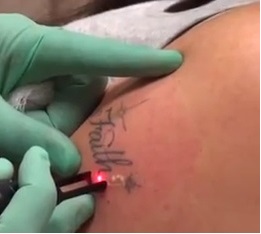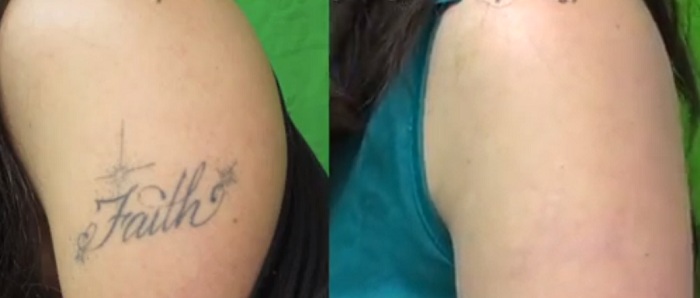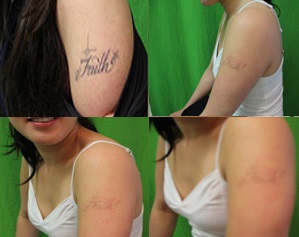The Office of Dr. U offers safe and effective laser tattoo removal procedures. If you are interested in getting rid of an unwanted design, it is important to choose the right expertise. This involves understanding information about the following areas:
1) knowing which laser energy to use
2) anticipating how much energy can be safely applied to fragment the ink pigment
3) understanding how individual skin types will react to the laser wavelengths used
4) knowing how a patient’s skin should be treated after the procedure.
In the right hands, your risk of complications will be lowered significantly. And you are likely to receive higher quality results.
Choosing Tattoo Removal
Most people are excited when they initially get their tattoos and expect to love and cherish their new design for as long as they live. But it is perfectly natural for attitudes to change over time. As we get older, self expression becomes a less important priority. And individuals are likely to feel different about their tattoos due to factors like:
- how their fashion and style tastes change
- the need to keep their tattoos covered for work
- social stigmas
Research shows that nearly 20% of individuals within the United States have one or more tattoos. And about 50% of this group eventually experiences regret and seeks to get rid of their inked designs.
However, this is a perfectly normal phenomenon. And thanks to the availability of lasers, individuals have access to a safe and effective means for removing their tattoos, compared to dubious skin creams being sold for this purpose.
How Does Laser Tattoo Removal Work?
Before understanding a general picture of how lasers are able to remove tattoo ink, it may first be of interest to learn about the basic history of this type of technology.
The Advent of Medical Lasers – A Brief Timeline
The term laser is actually an acronym which stands for the following:
- L – light
- A – amplication (by)
- S – simulated
- E- emission (of)
- R – radiation
The usage of this technology on human physiology dates back to the 1980s. At this time pulsed dye lasers were receiving formal approval for a wide range of different medical applications, including tattoo removal. The concept of using crystals to harness light pulses in order to break down ink pigment was seen as quite promising and revolutionary.
It wasn’t until the early 1990s that the first laser system, the Q-Switched Ruby laser, was approved for removing tattoos. This particular technology was particularly suited for breaking down green ink which is one of the most difficult colors to address.
In 1991, The Q-Switched Nd YAG (yttrium-aluminum garnet) laser was approved. It offered a more versatile range of offerings due to its capability to employ a wider range of wavelengths. This laser is able to treat colors such as: dark blue, black, red and orange
1992 saw the approval of the Q-Switched Alexandrite laser which can break down green and bluish-black inks.
A Summary of How Lasers Remove Tattoos
Laser energy is first absorbed by the tattoo pigment. This step is important in order to break the ink into smaller particles. Once this is accomplished, the remains are carried away by the immune and circulatory systems. Therefore, it is important to keep in mind that the actual clearing process is performed by the body. This phase takes several weeks.
Dr. U Discusses How Tattoo Removal With Laser Works
In this video, Dr. U gives a very brief summary of laser tattoo removal and how it works.
Different Wavelengths Remove Different Colors
(1) Nd: YAG 532 nm emits a green light which breaks up red and orange pigment
(2) Ruby 694nm emits a red light which is used to help remove green ink. This laser is quite easily absorbed by melanin and is therefore risky for ethnic skin tones.
(3) Alexandrite 755 nm is also a red light which targets green coloration. Compared to the Ruby 694nm system, this laser is much safer for darker skin.
(4) Nd YAG 1064 nm is a very unique wavelength which is quite resistant to being absorbed by surrounding melanin. Therefore, it offers a treatment that more precisely targets the tattoo ink without incurring potential risks to the skin tissue.
Removal of Multicolored Tattoos
Simple block designs (e.g. lettering) using dark colored ink are the easiest tattoos to remove. However, many individuals sport tattoos with multiple colors which is more challenging.
Addressing these types of designs requires the use of different dye modules. Simplistically, these can be thought of as filters for the laser energy which can increase or reduce it’s wavelength. With a dye module, for example, the 532nm wavelength can be converted to 650nm or 585nm. This accessory piece therefore allows the laser to address a wider range of tattoo colors.
Q-Switched Laser for Tattoo Removal
The concept of the Q-Switch laser involves the ability to change different factors to safely but effectively shatter unwanted tattoo pigment. In other words, it is not only important to administer the right amount of energy that would do the job of breaking up the pigment, but also to set limits that would ensure safety of the skin so that it does not overheat.
In Q-Switch lasers, different parameters can be adjusted to best suit individual cases:
(1) Pulse duration (pulse width)
This is important for removing tattoo pigments. In order to shatter these particles, lasers must have the ability to deliver high intensity bursts of energy that are safe for the patient. This is achieved by emitting the laser beams as shorter or longer pulses. Shorter pulses deliver more impact
(2) Spot size
This has to do with the actual width of the beam. Larger diameters are more effective than shorter ones in their ability to reach deeper layers of the skin
(3) Fluence
Fluence refers to the amount of energy delivered per square centimeter of the skin.
Number of Laser Sessions Needed to Remove A Tattoo
In most cases, multiple visits are needed to have a tattoo removed. The actual number will vary depending on various factors:
(1) Ink colors used
Darker colors will absorb laser energy much more easily than lighter colors. Therefore these pigments are easier to shatter and remove.
(2) Anatomical placement of the tattoo
Where the tattoo is located on the body matters. Some areas have a higher concentration of blood vessels than others. The circulatory system is important for actually carrying away the tattoo particles and clearing the skin. Therefore, a tattoo located on the abdomen, where are are a lot of blood vessels will take much less time to remove than a design placed on one of the outer extremities such as the hand.
(3) Amount of ink used
More ink will require more energy and more work to remove. This entails a greater number of sessions.
(4) Presence of scars or other forms of tissue changes
Scars are made of collagen fibers that may trap fragments of tattoo ink. This makes the pigment less accessible to the laser beam and thus harder to remove. Other forms of tissue changes may create a similar type of limitation.
(5) Presence of layering
Layering involves the placement of a new tattoo design on top of an older one. This basically equates to a greater amount of ink to remove and a larger number of sessions
(6) Skin type
Darker skin tends to absorb laser energy quite readily. Therefore there is the risk of overheating the skin and the creation of scars and unwanted discolorations. To help mitigate this possibility doctors will extend the number of sessions to minimize the amount of laser energy delivered during each treatment.
(7) Chronic smoking habits
In those who habitually smoke, the immune system is rendered less able to function at its optimum. Again, lasers help to break the pigment. But the body’s own natural systems actually do the work of clearing the ink away. And if the immune system (which provides cells that engulf the tattoo particles) is not performing as well as it should, patients may have to expect a much longer frame of time for achieving the results they want
(8) Age of the tattoos
Older tattoos are more difficult to remove than newer ones. Over time, phagocyte cells will transport pigment to deeper layers of the skin, making it harder for laser energy to reach these ink particles.
Commonly Asked Questions About Using Lasers to Remove Tattoos
How much do laser tattoo removal treatments cost?
The overall cost will depend on the number of sessions needed to achieve the final desired results. However, studies show that the average amount that people pay for their treatment series is about $750-$1000.
Does it hurt to undergo laser procedures for tattoo removal?
The amount of pain experienced will depend on individual tolerances and thresholds. Numbing cream is often applied to the skin’s surface. But it does not penetrate very deep. Many laser treatments requires that the beam extends well into the dermis layer. Therefore, the doctor may choose to inject a local anesthesia to improve the patient’s comfort level.
What happens to the skin following a laser tattoo removal session?
After a laser tattoo removal, the skin will be very red. And this redness will eventually develop into scabs. Therefore, the area will often need to be covered and treated with antibiotic ointment to prevent infections.
How often should treatment visits be scheduled?
Usually 4-6 weeks is the recommended frame of time between laser sessions. During these periods, the skin will be healing and the body will be clearing away the remains of pigment particles following each treatment.
How long should I wait until I get a new tattoo?
If you are getting a tattoo to cover up the old one, it is advised that you wait a few weeks. Also be sure that the remnants of the old design will not be visible through the new one. Therefore, you may need to undergo more treatment sessions before getting another tattoo.
Why am I not seeing good results after my laser treatment sessions?
Many patients report that they are not seeing a big difference during the initial phases of their treatment. But this is somewhat common and should not be necessarily be viewed as a source of discouragement. Keep in mind that there are many factors (see above) that play a role in how fast you will experience progress. Again, these include variables like: the color of your skin, the ink colors used and how old your design is.
Should I avoid exercise after my laser tattoo removal treatment?
Most laser tattoo removal practitioners will recommend that exercise is avoided for one to days following the session. The skin is very swollen and even subject to breakage. This is a very serious issue for larger tattoo designs.
When is surgical excision recommended over the use of lasers in tattoo removal?
Surgical excision may be recommended for smaller tattoos. But this approach will result in a scar once the wound is closed.
Laser Tattoo Removal at The Office of Dr. U
At Fine Touch Dermatology, you will receive the care of a board certified dermatologist for a successful outcome. Dr. Umar is an experienced specialist who is able to make the right decisions for your particular skin type and tattoo design. He is also an expert in removing tattoos from all ethnicities including:
- African American
- Caucasian
- Asian
- Hispanic
- Middle Eastern
Our clinic uses the Spectra VRM III laser system by Lutronic for laser tattoo removal. Besides being able to treat different skin types, Dr. Umar can also address various challenges such as:
1) large tattoos
2) multicolored designs
3) layered tattoos
4) shading used in three dimensional images
Photos of Laser Tattoo Removal on Los Angeles Patient
This Los Angles patient wanted to get rid of her black “Faith” tattoo. It only took three sessions for Dr. Umar to remove it using the Spectra laser.
Patient Video
The patient noted that her procedures weren’t very painful. And she was delighted that she no longer needed to hide her tattoo at work with long sleeves. Here is her video:
Los Angeles Laser Tattoo Removal – Consultations
If you are interested in speaking to a board certified dermatologist about tattoo removal with laser, sign up for a complimentary consultation at Fine Touch Dermatology. You may fill out our online form. Or you can call us at 877-337-6424.




